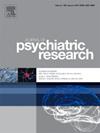反刍是近期住院成人日常消极生活事件与自杀意念之间的间接途径
IF 3.7
2区 医学
Q1 PSYCHIATRY
引用次数: 0
摘要
消极的生活事件通常被认为是自杀意念的近期风险因素;然而,反思过程可能在放大负面生活事件经历后的痛苦方面发挥关键作用,最终导致更大的自杀风险。在当前的工作中,我们在一项日水平生态瞬间评估(EMA)研究中考察了反刍是否间接影响了消极事件与SI强度之间的关联。参与者(N = 107;年龄35.9岁,65%女性,81%白人)在精神病住院后完成了65天的EMA方案。我们使用动态结构方程模型来检验负事件、反刍和SI强度之间的直接和间接影响的日水平、人体内模型。在对所有人的模型进行拟合后,我们推导了个体特异性估计,以检验模型参数的异质性(即,虽然间接效应在整个样本中可能是显著的,但效应大小可能在个体之间有所不同)。结果表明,反刍的间接效应在全样本中显著(非标准化估计= 0.026),占总效应的38.058%。此外,个人特异性检查的结果表明,在EMA数据的任何点报告SI的几乎所有参与者都存在间接影响。因此,除了强调反刍在自杀行为中发挥的关键作用外,本研究还强调了开展针对个体的研究以了解自杀风险中涉及的心理过程的复杂性和异质性的价值。本文章由计算机程序翻译,如有差异,请以英文原文为准。
Rumination as a within-person indirect pathway between daily negative life events and suicidal ideation in recently hospitalized adults
Negative life events are often implicated as a near-term risk factor for suicidal ideation (SI); however ruminative processes may play a critical role in amplifying the distress following experiences of negative life events, ultimately leading to greater suicide risk. In the present work, we examined whether rumination indirectly impacted the association between negative events and SI intensity in a day-level ecological momentary assessment (EMA) study. Participants (N = 107; Mage = 35.9 years, 65% female, 81% white) completed an EMA protocol for 65 days following psychiatric hospitalization. We used dynamic structural equation modeling to test a day-level, within-persons model of direct and indirect effects between negative events, rumination, and SI intensity. After fitting the model across all people, we derived person-specific estimates to examine heterogeneity in the model parameters (i.e., while the indirect effect may be significant in the full sample, effect sizes may vary across individuals). Results indicated that the indirect effect of rumination was significant in the full sample (unstandardized estimate = 0.026) and represented 38.058% of the total effect. Moreover, results for the person-specific examination indicated that the indirect effect was present for nearly all participants who reported SI at any point in their EMA data. Thus, in addition to highlighting the critical role that rumination can play in SI, this study also highlights the value in conducting person-specific research to understand the complexity and heterogeneity of psychological processes involved in suicide risk.
求助全文
通过发布文献求助,成功后即可免费获取论文全文。
去求助
来源期刊

Journal of psychiatric research
医学-精神病学
CiteScore
7.30
自引率
2.10%
发文量
622
审稿时长
130 days
期刊介绍:
Founded in 1961 to report on the latest work in psychiatry and cognate disciplines, the Journal of Psychiatric Research is dedicated to innovative and timely studies of four important areas of research:
(1) clinical studies of all disciplines relating to psychiatric illness, as well as normal human behaviour, including biochemical, physiological, genetic, environmental, social, psychological and epidemiological factors;
(2) basic studies pertaining to psychiatry in such fields as neuropsychopharmacology, neuroendocrinology, electrophysiology, genetics, experimental psychology and epidemiology;
(3) the growing application of clinical laboratory techniques in psychiatry, including imagery and spectroscopy of the brain, molecular biology and computer sciences;
 求助内容:
求助内容: 应助结果提醒方式:
应助结果提醒方式:


